|
1.
CENTRAL AND WEST AFRICA
Regional update
Gabon
Operations remain subdued with market demand still weak
and buyers largely absent. GPS-linked log traceability
remains strictly enforced in line with EUTR compliance.
All sawnwood bundles are being checked for compliance
before export.
European buyers have returned from summer holidays but
ordering remains slow as stocks in the main markets
remain high. Chinese demand is extremely weak while
European orders are mostly on a supply-on-demand basis.
It has been reported that demand for Okan has weakend in
both China and the Netherlands, said to be due to
oversupply and the recent focus of mills to cur Azobe. The
local market remains active for Okoume and Bilinga.
Okoume peelable logs are selling in the NKok zone at
80,000 CFA/pcbm, while CS-grade Okoume logs are at
85,000 CFA/pcbm.
Local sawn logs are trading at 60,000 CFA/pcbm and
prices for sawn Okoume are steady at 140,000 CFA/pcbm.
The GSEZ log park is said to hold about 10,000 cu.m of
mostly low-grade Okoume alongside Bosse, Sapelli,
Padouk and small volumes of Azobe and Okan.
The rain season has returned but thanks to ongoing work
roadtransport has improved on the main forest to port
routes, including Okonja–Makoukou–Lastourville–
Ovang–Lope–Ndjole to Bifoun. Deliveries to Libreville
are moving more steadily as road works progresses. The
government has launched a plan to repair 3,000 km of
roads over four years, with priority given to the most
critical sections.
Rail transport remains problematic. The Union des
Forestiers et Industriels du Bois du Gabon (UFIGA)
continues to pressure the government on the performance
of SETRAG. Recurrent derailments and poor maintenance
are frustrating travellers and delaying log transport. The
government has demanded that SETRAG overhaul its 40-
year-old network within a year with funding support from
the African Development Bank.
Milling continues to be disrupted by power cuts. The
government has pressed SEEG (the national electricity
company) to stabilise supply. Two Turkish floating power
units are already in place with a third ship expected to
raise output to 228,000 kWh. However, installation of this
new capacity is resulting in short term power cuts
Political activity is intensifying as Gabon heads to local
elections on 27 Septembe, the first real test for the
President’s new party, Les Bâtisseurs.
In what is said to be a surprise move the government has
also ordered that “low-level jobs” such as taxi services,
small shops and manual work be reserved for Gabonese
citizens. This directive has created pressure on Beninese
workers who currently work in the country. The Benin
government has requested negotiations on this issue.
Cameroon
Persistent heavy rains are causing delays in production and
driving down output volumes. By the end of September
most sawmills are expected to close temporarily due to the
upcoming presidential elections. More than half of the
Chinese-operated mills remain closed.
Many operators have left the country ahead of the October
presidential elections citing both political uncertainty and
weak market conditions. They are expected to return at the
end of October once the election period has passed.
Domestic sawmills are also slowing down, with new
contract demand delayed.
Operators had briefly increased production earlier in the
dry season by repairing roads but demand is now weak so
production has been scaled back. Chinese buyers, in
particular, are not showing very much interest and this
lack of demand is unsettling operators.
Transport to ports continues without major disruption and
container availability is sufficient, with no shortages of
empty boxes reported. Port operations remain steady and
shipments are dispatched as planned.
Middle Eastern markets are stable, particularly for species
such as Iroko, Sapelli, and other redwoods but the low
density species are not moving in the Middle East.
European orders are being placed and fulfilled quickly as
Cameroon can respond efficiently to smaller, short-term
contracts.
The looming EUDR is causing concern among operators
in both the timber and agricultural sectors as the EUDR
applies to many agricultural products. CITES requirements
are creating additional difficulties with operators
experiencing heavy delays document processing.
European importers are also reportedly under pressure as
CITES procedures complicate transactions.
The timber industry remains highly sensitive to the
political climate. With presidential elections scheduled for
12 October many mills are expected to suspend operations
at the end of Septembe ralthough some legal advisors
indicate closures will only be necessary during the
immediate election period of 10–14 October.
Republic of Congo
Demand in international markets remains relatively quiet.
Harvesting continues at normal levels though rains are
disturbing operations and creating some challenges on
laterite roads. Repair work is ongoing in certain areas so
trucking remains functional but slowed by weather.
Transport routes to Douala port are operational.
Demand pressures are being felt with Philippine interest in
Okoume declining and Middle Eastern demand also
weakening. This has left sawmills with few options
beyond small contracts to southern Europe, particularly
Portugal and Italy. Demand is stable but uneven across
markets. Purchases of Okoume sawn timber by the
Philippines is declining while Tali shipments to Vietnam
continue to support mill activity.
Port operations remain stable with shipments proceeding
normally. Container availability is not a present an issue.
While some weather-related delays exist, overall export
flows are functioning without serious disruption.
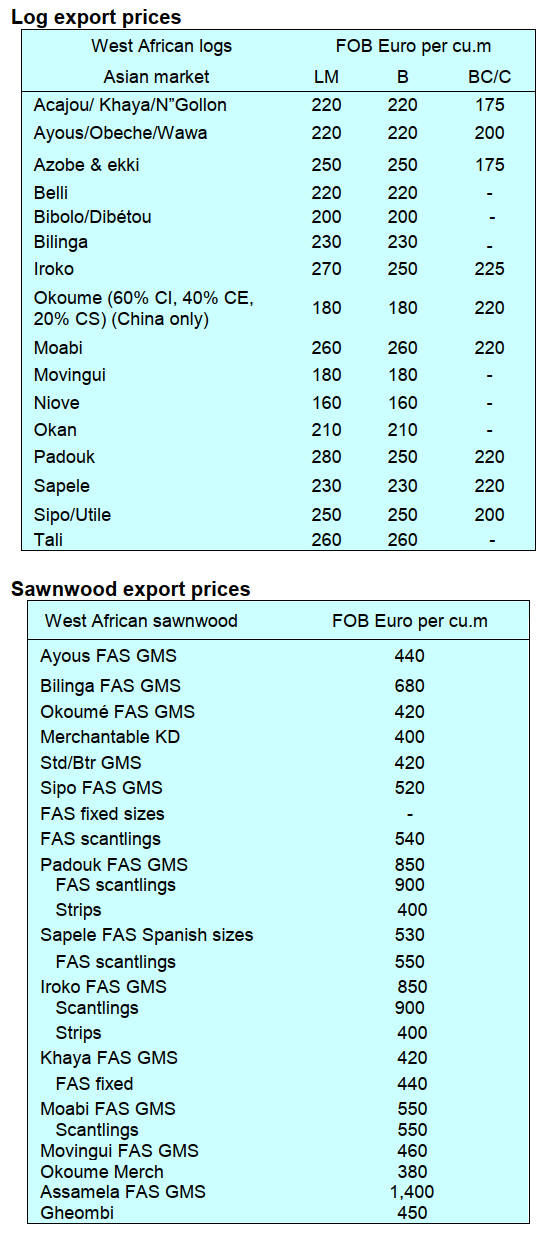
2.
GHANA
Measures to end illegal mining in forest reserves
As part of measures to curtail the alarming rate of illegal
mining in Ghana’s forest reserves which has polluted and
destroyed some of the country’s water bodies, the
government has taken some steps to strengthen
environmental protection under the Environmental
Protection Agency (EPA).
The Acting Minister for Environment, Science and
Technology, Emmanuel Armah-Kofi Buah, has formally
written to the Office of the Attorney General for the
immediate revocation of Legislative Instrument (L.I.)
2462 and its amended version, L.I. 2501.
The L.I., passed in 2022 under Environmental Protection
(Mining in Forest Reserves) Regulation, allowed for
mining activities in forest reserves with some exceptions
and requirements for environmental management.
In a statement issued by the Director of Communications
for the Lands Ministry, Ama Mawusi Mawuenyefia, the
Minister assured the public that revoking the L.I. will not
create a regulatory vacuum. The statement expressed
confidence that the Environmental Protection Agency's
(EPA) existing framework will provide robust provisions
to govern all mining activities and ensure strict
compliance with environmental standards.
He added that this critical step is intended to unify and
strengthen the regulatory framework, creating a cohesive
front for all stakeholders in the national fight against
illegal mining.
In late 2024 government began the process of revoking
this law following calls from environmental groups and
civil society organisations. Forestry Commission statistics
indicate that the country loses about 120,000 hectares of
forest cover annually, much of which is linked to
agricultural expansion activities and the menace of illegal
mining.
See: https://www.myjoyonline.com/acting-environment-minister-
armah-kofi-buah-writes-to-attorney-general-for-immediate-
revocation-of-l-i-2462/
Wood product exports to African market slump while
ECOWAS sees growth
Cumulative timber and wood product exports in the first
six months of 2025 through Takoradi and Tema Ports as
well as overland stood at Eur51.63 million, representing a
15% decrease compared to the Eur60.58 million traded in
the same period of 2024 according to data source from the
Timber Industry Development Division (TIDD).
In the first half of the year Africa’s market share of
Ghana’s product exports dipped from 13,175cu.m. in 2024
to 10,186cu.m in 2025. These exports generated revenues
of Eur4.28 million for the period in 2025 compared to
Eur5.42 million, a decline of 21% in value.
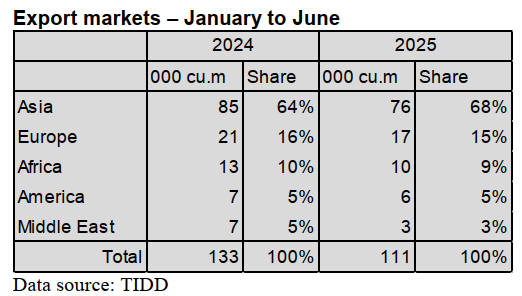
The data revealed that overland exports to neighboring
ECOWAS countries accounted for Eur3.13 million from
8,069 cu.m of the total African wood products exported
from January-June 2025 as compared to Eur3.85 million
obtained from 10,277 cu.m during the same period of
2024.
Ghana’s wood products export to the regional market for
the period included plywood, kiln dried sawnwood, sliced
veneer and poles.
Plywood dominated exports accounting for 99% of the
regional export volumes for 2024 and 2025. The total
value of overland plywood exports during the half year
was Eur3.85 million in 2024 compared to Eur3.13million
in 2025.
The average unit price registered an increase of 3.5% from
Eur375 per cu.m. in January-June 2024 to Eur388 per
cu.m. in the same period of 2025.
Plywood exports by sea went to Gambia (35%), South
Africa (23%) and Senegal (22%) altogether accounted for
80% of total export volume for the period January to June
2025. The major species used in plywood production
included chenchen, ceiba, cedrela, eucalyptus and
gmelina.
The major markets for the African trade included Egypt,
Morocco and South Africa. While Togo, Burkina Faso,
Niger, Gambia, Mali, Benin, Cote D’Ivoire, Nigeria and
Senegal were the markets for the ECOWAS.
Strengthening forest governance
The Minister for Lands and Natural Resources, Emmanuel
Armah-Kofi Buah, has inaugurated a Timber Validation
Committee with a mandate to enhance transparency,
accountability and credibility in Ghana’s timber industry.
In his inaugural address, the Minister said the committee
would play a vital role in safeguarding Ghana’s forests
while ensuring that all timber products meet both domestic
and international standards. He hailed Ghana’s recent
milestone of issuing its first Forest Law Enforcement,
Governance and Trade (FLEGT) license for timber exports
to the European Union.
Mr. Armah-Kofi Buah described the step as the country’s
bold statement of commitment to legality, transparency
and sustainability in the global timber trade.
The Minister tasked the Committee with the need to work
hard to preserve the country’s forests as a national heritage
we owe to our children and grandchildren. He pledged
government’s full support to the committee to help it carry
out its work effectively.
The Committee Chairman, Fiifi Buckman, expressed
gratitude on behalf of members and assured stakeholders
of their professionalism and integrity.
See:https://www.myjoyonline.com/lands-minister-inaugurates-
timber-validation-committee-to-strengthen-forest-
governance/#google_vignette
VAT to be lowered to 20% in 2026
The final Value Added Tax (VAT) rate that will be paid
by businesses is expected to be reduced from 22% to 20 %
from 2026. This will be captured in the 2026 Budget,
which the Finance Minister Dr. Ato Forson, disclosed
could be presented to parliament in October 2025.
When meeting the press, Commissioner General of the
Ghana Revenue Authority (GRA), Anthony Sarpong,
noted that the government is committed to reducing the tax
burden on businesses. He said the new VAT bill should be
ready by September this year before the next budget
reading.
Meanwhile, in a bid to make the payment of VAT, taxes
and filing convenient the GRA has now moved towards a
more digitalised economy for taxpayers to file returns and
pay taxes online with ease.
The Association of Ghana Industries (AGI) among other
manufacturing companies have complained of the
complex and double VAT taxation system encouraging the
government to review, consolidate and to make payment
convenient for taxpayers.
See: https://www.vatupdate.com/2025/08/16/ghana-reduces-vat-
to-20-in-major-tax-reform-to-boost-compliance-and-ease-
business-burden/
Ghana’s economy grew 6.3% in the second quarter
According to the Ghana Statistical Service (GSS)
provisional data release, Ghana’s economy grew by 6.3%
in the second quarter of 2025. The data revealed that the
real Gross Domestics Product (GDP) increased by 1.4% in
second quarter of 2025, from 1.6% in the first quarter of
this year.
Meanwhile, according to IC Research a leading market
research firm, the Monetary Policy Committee of the Bank
of Ghana will likely announce a second successive interest
rate cut at the September 2025 meeting.
See:https://www.graphic.com.gh/business/business-news/ghana-
news-economy-grows-6-3-in-2nd-quarter-driven-by-services-
industry.html
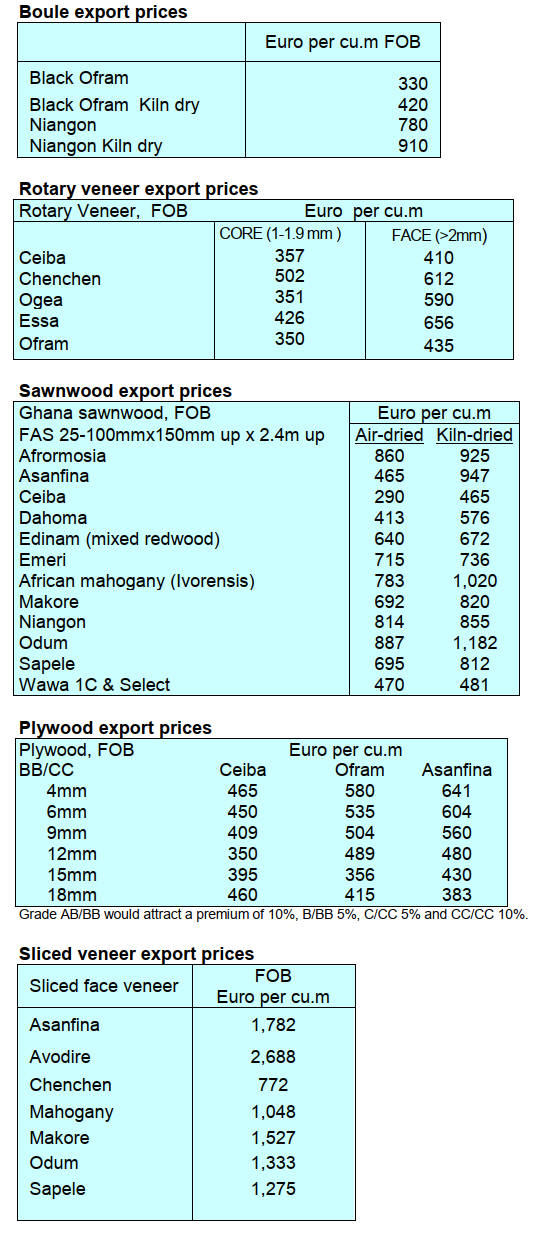
3. MALAYSIA
Malaysia committed to 50% forest cover
Malaysia is currently maintaining 54.3% of its land area as
forests according to Johari Abdul Ghani who is currently
overseeing the Ministry of Natural Resources and
Environmental Sustainability.
He said the country remains committed to maintaining at
least 50% of its land mass under forest cover in line with
the pledge made to the United Nations in 1992.
He added that forest plantations established in forest
reserves (HSK) are not categorised as having resulted in
deforestation as this involve replanting rather than
permanent conversion of forest land to non-forest use.
"As of June 30 this year the total area of forest plantations
in Peninsula Malaysia stood at 259,654ha. of which
175,331ha. have been replanted. These plantations are
established to ensure a continuous supply of raw material"
he told the Malaysian Parliament.
Johari said harvesting within forest reserves is strictly
controlled. "States are allowed to harvest no more than 5%
of their HSK areas at any one time. After harvesting, the
area must be replanted, only then can a further 5% be
opened. This way, we ensure biodiversity is protected
while maintaining forest cover," he said.
See:
https://www.nst.com.my/news/nation/2025/08/1265761/malaysia
-affirms-50pct-forest-cover-pledge-amid-concerns-over-
timber?topicID=1&articleID=1265761
Minister - furniture industry must prioritise innovation,
sustainability and design
The Deputy Plantation and Commodities Minister, Chan
Foong Hin, has said Malaysia’s furniture industry must
prioritise innovation, sustainability and design to remain
globally competitive instead of relying solely on price. He
noted that Malaysia enjoys a slight tariff advantage over
Vietnam in the United States market, 19% compared with
Vietnam’s 20%. Vietnam is among Malaysia’s main
competitors in the global furniture market, with both
countries vying for market share particularly in the home
and office furniture segments.
“We have an advantage but in the long run, I don’t think
price will be the only factor, innovation is key. Malaysia
must move from only manufacturing in Malaysia to
manufacturing and designing by Malaysia,” he said at the
opening of the Malaysia Furniture Furnishings Market
2025 (MFFM).
Chan added that international buyers are increasingly
demanding eco-certified products with the Malaysian
Timber Certification Council (MTCC) encouraging local
manufacturers to obtain certification to strengthen their
credibility.
Despite global headwinds, Chan said the timber industry
remained resilient with exports rising 4.9% to RM22.9 bil
in 2024. Wooden furniture contributed RM9.9 bil, up
8.4% and now accounts for more than 40% of Malaysia’s
total wood product exports to more than 160 countries.
Chan attributed this success to strong craftsmanship,
design innovation and collaboration with agencies such as
the Malaysian Timber Industry Board (MTIB), MTC and
MTCC.
Over 370 companies are now certified under the
Malaysian Timber Certification Scheme, endorsed by the
Programme for the Endorsement of Forest Certification
(PEFC) giving Malaysia global recognition as a trusted
source of responsibly made furniture.
Looking ahead, Chan identified three megatrends that will
shape the industry, sustainability and ESG (environment,
social and governance), digital transformation and design
innovation. “Compliance with international standards is no
longer optional. Industry 4.0 technologies are reshaping
the way furniture is designed and manufactured and the
government is supporting SMEs with assessments and
matching grants,” he said.
See:
https://www.thestar.com.my/news/nation/2025/09/04/innovation-
the-key-to-malaysian-furniture-industry039s-future-says-deputy-
minister
Global conservation expertise comes to Sarawak
Sarawak Energy’s climate and biodiversity efforts reached
a new milestone with the official handover of the Dataran
Seping Carbon Study Permit (CSP) from the Forest
Department Sarawak and the signing of a Memorandum of
Understanding (MoU) with the International Union for
Conservation of Nature (IUCN) bringing global
conservation expertise to Sarawak.
Sarawak Energy is an electric power utility company. Both
initiatives, unveiled at the Sustainability & Renewable
Energy Forum (SAREF 4.0), strengthen Sarawak Energy’s
nature-based solutions projects and its pathway towards
net zero.
The Carbon Study Permit grants Sarawak Energy the legal
approval to commence feasibility studies for its NbS
projects within hydropower catchments. These projects are
projected to generate more than 250,000 carbon credit
units, which will offset emissions from hard-to-abate
generation sectors and support the company’s Net Zero
Action Plan.
The initiative, guided by the Hydropower Sustainability
Standard (HSS), leverages NbS to strengthen water
resource resilience, biodiversity protection and long-term
community benefits.
See: https://dayakdaily.com/sarawak-energy-secures-dataran-
seping-carbon-study-permit-partners-with-iucn-to-drive-nature-
based-climate-solutions/
Japanese company funding mangrove restoration
The Sabah Government, through the Sabah Forestry
Department (SFD), has renewed its commitment to
mangrove conservation by signing a Memorandum of
Understanding (MoU) with the International Society for
Mangrove Ecosystems (ISME). Launched in 2011, the
SFD–ISME Mangrove Rehabilitation Project has grown
into one of Sabah’s most significant conservation
initiatives.
Now entering its fourth phase (2024–2029), the project
will continue with the support of Tokio Marine & Nichido
Fire Insurance Co. Ltd., Japan, which is providing funds to
restore degraded mangroves across the State.
Since its inception, the project has successfully restored
556 hectares of mangrove forests, benefitting coastal
ecosystems and local communities. Beyond rehabilitation
the collaboration has also advanced scientific research on
mangrove ecosystems.
See: https://www.dailyexpress.com.my/news/265428/sabah-
renews-mangrove-rehab-deal/
3D LiDAR technology to measure forest structure
The Forest Department Sarawak (FDS) has signed a
Memorandum of Agreement (MoA) and a Memorandum
of Understanding (MoU) with Arbonaut Ltd, a leading
international company in forestry and geospatial
technology.
Arbonaut Ltd. has been appointed as the consultant for the
project ‘Quantifying Stand Structure Dynamics and
Productivity in Natural Forest and Planted Forest Stands
Using Airborne 3D Ranging Systems’.
According to FDS, the project will utilise 3D LiDAR
technology to measure forest structure, growth dynamics
and productivity in both natural forests and industrial tree
plantations. The technology is expected to improve the
accuracy of forest inventory parameters such as tree
height, volume, biomass, carbon stocks and forest fire risk
assessments.
In addition, FDS signed a five-year MoU with Arbonaut
Ltd. outlining collaboration in areas including forest
carbon assessment, carbon project development and
trading. The MoU also covers joint research in
biodiversity, forest products, fire management, soil science
and pathology, as well as technical information exchange,
knowledge transfer and the use of remote sensing in forest
inventory systems, sustainable forest management, forest
traceability and forest information systems.
See: https://www.theborneopost.com/2025/08/27/forest-dept-
sarawak-seals-moa-mou-with-finlands-arbonaut-ltd-to-boost-
forestry-tech-collaboration/
4.
INDONESIA
Export Benchmark Prices (HPE)
The following is a list of Wood HPE from 1 to 30
September 2025.
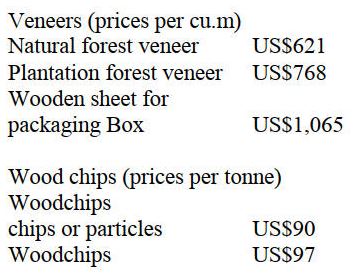
Processed wood (prices per cu.m)
Processed wood products which are leveled on all four
sides so that the surface becomes even and smooth with
the provisions of a cross-sectional area of 1,000 sq.mm to
4,000 sq.mm (ex 4407.11.00 to ex 4407.99.90)
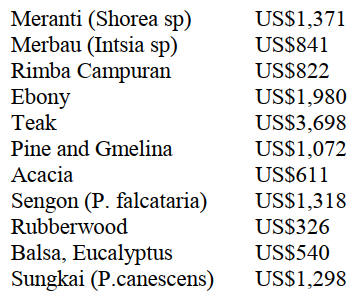
Processed wood products which are levelled on all four
sides so that the surface becomes even and smooth of
Merbau wood with the provisions of a cross-sectional area
of 4,000 sq.mm to 10,000 sq.mm (ex 4407.11.00 to ex
4407.99.90) = US$1,500/cu.m
See: https://jdih.kemendag.go.id/peraturan/keputusan-menteri-
perdagangan-republik-indonesia-nomor-1844-tahun-2025-
tentang-harga-patokan-ekspor-dan-harga-referensi-atas-produk-
pertanian-dan-kehutanan-yang-dikenakan-bea-keluar
Calls for a simplification of regulations
A number of forestry and economic experts are urging the
Indonesian government to simplify regulations to
revitalise the national timber industry and boost its
competitiveness. They argue that the current rules are
hindering investment, weakening production and reducing
the forestry sector's contribution to the economy.
Specifically, Bogor University IPB forestry specialist,
Sudarsono Sudomo, believes that the Timber Legality and
Sustainability Verification System (SVLK) creates more
costs than benefits and that many growers do not know
they have to obtain the required certificate. He also refutes
the claim that natural forest management is the main cause
of deforestation, stating that land conversion is a more
frequent cause.
The experts' call for action is supported by data showing a
sharp decline in the industry. From 1990 to 2023 the
number of active forestry businesses in natural forests has
fallen from about 600 to just 250. According to Sudarsono,
the industry also has a low capacity for job creation,
absorbing only about 1,500 workers for every Rp1 trillion
in investment.
Forestry analyst, Petrus Gunarso, highlighted that the issue
of timber traceability is often misunderstood, noting that
international NGOs often label the conversion of natural
forests to timber plantations as deforestation.
See:https://ekonomi.republika.co.id/berita/t2ax0b522/pemerintah
-didorong-permudah-regulasi-industri-kayu-nasional
and
https://investor.id/business/408872/regulasi-industri-kayu-perlu-
dipermudah#goog_rewarded
and
https://www.liputan6.com/bisnis/read/6154684/bebani-
pengusaha-pemerintah-diminta-permudah-regulasi-industri-kayu
SVLK verified wood pellets
The Indonesian Ministry of Forestry has confirmed that
Indonesian wood pellets exported with a V-Legal/FLEGT
License meet the Timber Legality and Sustainability
Verification System (SVLK). This provides a guarantee
that the products originate from legal and sustainable
sources that fully comply with Indonesian law.
This clarification was made during a meeting with
Japanese industry representatives and was a direct
response to accusations from several NGOs that the wood
pellet industry was causing deforestation.
According to Tony Rianto, Head of the Sub-Directorate of
Forest Product Certification and Marketing at the Ministry
of Forestry, the SVLK scheme is comprehensive, covering
not only legal aspects but also social, ecological and
business factors. Industries that utilise SVLK-certified raw
materials are therefore assured of both ecological and
economic sustainability. He stated that the SVLK system
is the government's way of protecting forests, preventing
deforestation and supporting the transition to clean energy
by ensuring the pellets come from legal and sustainable
sources.
See: https://industri.kontan.co.id/news/penuhi-svlk-produk-
wood-pellet-indonesia-dijamin-legalits-dan-kelestariannya
Indonesian furniture and craft at VIFA ASEAN
The Indonesian Furniture and Craft Industry Association
(HIMKI) is strengthening the presence of Indonesian
products in the global market by participating in the VIFA
ASEAN 2025 International Furniture and Home
Accessories Fair in Viet Nam. This is the second time
HIMKI has participated in the event.
According to Marthunus Fahrizal, HIMKI's Head of
International Institutional Relations, this exhibition was a
crucial opportunity to gain access to the global market,
particularly within the fast-growing Southeast Asian
region.
HIMKI attended the Fair with six member companies to
showcase the quality and diversity of Indonesian furniture
and craft products. This participation aimed to introduce
the products to international consumers, investors,
designers and other professionals. The Association's
involvement in the event was a key part of its commitment
to solidify Indonesia's position on the international
furniture and craft industry map.
See: https://investor.id/business/407677/industri-furnitur-
perkuat-penetrasi-di-pasar-asean
In related news, Indonesia participated in the Korea
International Furniture and Interior Fair (KOFURN) 2025
in Goyang City, South Korea held from August 28-31.
This event is South Korea's largest international furniture
and interior exhibition and twelve leading Indonesian
furniture companies took part.
The participation was a strategic initiative by Indonesia's
Ministry of Trade, the Indonesian Embassy in Seoul, the
Indonesian Trade Attaché in Seoul and Indonesia
Eximbank in order to promote high-quality Indonesian
furniture and strengthen its position in the South Korean
market.
The Indonesian Pavilion showcased a variety of products,
including wooden furniture, upholstered chairs, home
interior furnishings and innovative designs using eco-
friendly materials.
In addition to the exhibition, the participating companies
also engaged in business-matching sessions to connect
with potential buyers from South Korea and other Asian
countries. The Deputy Chief of Mission at the Indonesian
Embassy in Seoul, Ali Andika Wardhana, said this
participation will create more trade opportunities for the
Indonesian companies.
See: https://wartaekonomi.co.id/read580913/ri-perkenalkan-
desain-dan-kualitas-produk-furnitur-lokal-ke-korea-selatan
Impact of US tariffs on Indonesian furniture and
handicrafts
According to the Indonesian Furniture and Handicraft
Industry Association (HIMKI) the US accounts for 55-
60% of Indonesia's total global exports of furniture and
handicraft with a value of US$2.43 billion in 2024.
Although details of the US 232 investigation are still
unknown, the uncertainty has prompted Indonesian
businesses to begin preparations.
The HIMKI is undertaking several mitigation efforts
including forming a coalition with the American Home
Furnishings Alliance (AHFA) and seeking an exemption
in coordination with the Indonesian Embassy in
Washington. The Association plans to provide evidence
that additional tariffs would ultimately raise furniture
prices for American consumers.
For the medium term, HIMKI is considering more
significant strategic shifts. This includes the possibility of
relocating or establishing new production facilities in
countries that have existing free trade agreements (FTAs)
with the US such as Jordan. Additionally, the Association
is exploring alternative export markets to reduce its
dependence on the US including Western Europe, Japan,
Australia, the Middle East and ASEAN countries.
See: https://www.msn.com/id-id/politik/pemerintah/trump-mau-
pasang-tarif-impor-furnitur-bagaimana-nasib-mebel-dan-
kerajinan-indonesia/ar-AA1L6TVE?ocid=BingNewsVerp
and
https://www.msn.com/id-id/berita/other/as-bakal-terapkan-tarif-
tinggi-furnitur-produsen-berharap-prabowo-turun-tangan/ar-
AA1L6uBN?ocid=BingNewsVerp
Improving access to capital and financial services
The Financial Services Authority (OJK) and the Ministry
of Forestry have entered into a collaboration aimed at
increasing access to capital and financial services for
farmers managing social forestry areas. The partnership
establishes eight key areas of cooperation, with the
primary objective being to encourage banks to provide
loans to these forest farmers.
According to Forestry Minister, Raja Juli Antoni, this
initiative is crucial for helping communities make their
lands more productive, thereby improving their welfare
and contributing to economic growth.
The collaboration directly addresses a long-standing issue
where forest farmers struggled to obtain capital because
their social forestry management submissions were not
accepted by financial institutions.
By working with the OJK the government hopes to make
these farmers "more bankable," allowing them to secure
the financing needed to develop their land. This effort is
also expected to boost the economic literacy of the
communities involved and ensure that forests remain
sustainable.
See: https://en.antaranews.com/news/376817/ojk-govt-
collaborate-to-expand-access-to-capital-for-forest-farmers
https://rri.co.id/daerah/1802005/ojk-kemenhut-jalin-kerja-sama-
dorong-pembiayaan-perhutanan-sosial
https://jakartaglobe.id/special-updates/ojk-and-forestry-ministry-
strengthen-synergy-between-financial-services-and-forestry-
sectors#goog_rewarded
Ministry projects 2026 budget to boost investment
The Ministry of Forestry in Indonesia has projected a
proposed 2026 budget of Rp6.039 trillion (approximately
US$367.8 million). Key priorities include protecting
forests as the "lungs of the planet," regulating water
systems, and managing forest rehabilitation and wildfire
control. This budget is also projected to create over
400,000 jobs contribute to the national target of reducing
greenhouse gas emissions by 15 percent from the forestry
sector.
Furthermore, the Ministry is committed to equitable forest
governance by providing community access to forest
management and streamlining permit regulations. The
budget will also be used to support food and energy
security through the development of agroforestry, multi-
business forestry and the down-streaming of forest
products.
See:https://en.antaranews.com/news/378465/forestry-ministry-
projects-2026-budget-to-boost-investment
and
https://koran-jakarta.com/2025-09-07/anggaran-kemenhut-2026-
disiapkan-untuk-dorong-kebijakan-kehutanan-berkelanjutan
US$ 1.3 Billion for domestic industry revitalisation
The Indonesian government has allocated up to IDR20
trillion (approximately US$1.3 billion) to revitalise
domestic industries.
The goal of this initiative is to strengthen the industries'
global competitiveness and create more employment
opportunities.
The funding will be sourced from the government-backed
Kredit Usaha Rakyat (KUR), or People's Business Credit,
program, which offers a subsidized interest rate of 5%.
The programme will specifically target labor-intensive
sectors such as the textile and textile products industry,
food and beverage industry and furniture industry.
See: https://rri.co.id/en/business/1815639/indonesia-allocates-
usd-1-3-billion-for-domestic-industry-revitalization

5.
MYANMAR
Exports of veneer to India and China
Myanmar exports veneer sheets, sheets for plywood and
other wood products to India and China. In 2024 Myanmar
earned US$9.61 million from exports to India
and US$19.34 million from exports to China according to
the United Nations COMTRADE database on
international trade.
China remains a larger buyer of veneers for plywood
manufacture from Myanmar, roughly double what India
bought in 2024 (US$19.34 mil. vs. US$9.61 mil.) The
figures are relatively modest. It is to be noted that the trade
channel with India is almost all by sea while the trade with
China is believed mainly the informal cross-border trade.
See -
https://tradingeconomics.com/myanmar/exports/india/veneer-
sheets-sheets-plywood-
wood and https://tradingeconomics.com/myanmar/exports/china/
veneer-sheets-sheets-plywood-wood
Acting President Visits China
Acting President Min Aung Hlaing paid a visit to China,
attending the Shanghai Cooperation Organization (SCO)
Summit in Tianjin and holding a meeting with Chinese
President Xi Jinping.
The trip, which took place from 30 August to 1 September
2025 is being widely interpreted as a strategic move to
solidify ties with China amid ongoing internal conflict and
ahead of a planned general election in Myanmar.
In related news, Min Aung Hlaing stated that the Myitsone
Dam project, which has been suspended for more than a
decade, would be restarted. Decisions were made on the
need to expedite the implementation of several projects
between Myanmar and China, including the Kyaukphyu
project, the Myitsone project, the oil and gas pipeline
projects and the Mandalay-Muse railway project.
See:
https://www.fmprc.gov.cn/eng/xw/zyxw/202508/t20250830_116
98908.html?utm_source=chatgpt.com
and
https://www.irrawaddy.com/news/burma/myanmar-junta-chiefs-
china-visit-hailed-as-successful-and-fruitful-by-
regime.html?utm_source=chatgpt.com
Recovery loans for earthquake hit SMEs
The Central Bank has announced it will provide 700
billion kyats in recovery loans to businesses and people
affected by the powerful earthquake on March 28. The
funds will be used for a disaster recovery fund to rebuild
the areas damaged by the powerful Sagaing earthquake. Of
the initial 700 billion kyats, 500 billion will come from the
National Natural Disaster Management Fund and 200
billion will come from the Central Bank's Market
Stabilisation Fund.
The loans will have terms of three to five years and will
cover a variety of needs. These include loans for
rebuilding homes and buildings, working capital for small
and medium-sized enterprises (SMEs) and funds for
machinery, water, electricity and solar investments. Loans
will also be available for the repair and operation of large
factories, as well as short-term loans for construction
companies responsible for rebuilding state-owned
infrastructure.
The 7.7 magnitude Sagaing earthquake caused extensive
damage to homes, buildings and resulted in a high number
of casualties in regions including Naypyidaw, Mandalay,
Sagaing, Magway, Bago and northeastern Shan State.
See: https://burmese.dvb.no/post/722811
Kyat’s Stability
According to Myanmar Economic Monitors from The
World Bank, the Myanmar kyat (MMK) has appeared
stable over the past three months, with official figures
even suggesting a modest appreciation. Analysts caution,
however, that this stability reflects government controls
rather than underlying economic strength.
The Central Bank of Myanmar (CBM) continues to peg
its reference rate at MMK2,100 per US dollar while banks
and trade transactions operate closer to MMK3,600 per
dollar. In the informal market, rates remain higher
still around MMK4,300.
The World Bank’s latest Myanmar Economic
Monitor notes that parallel market volatility has eased
since late 2024, but stabilisation does not equal recovery.
Inflation remains high, headline inflation reached 34%
year on year to April 2025 and import costs continue to
squeeze businesses.
See-
https://documents1.worldbank.org/curated/en/099061125205014
652/pdf/P507203-cbcf81b5-0107-4517-8ad7-
82b588a6328f.pdf?utm_source=chatgpt.com, https://forex.cbm.g
ov.mm/index.php/fxrate?utm_source=chatgpt.com
and
https://www.vdb-loi.com/mm_publications/revisions-to-foreign-
exchange-rates-for-taxation-on-imports-and-or-exports-and-
personal-income-tax-payments-
currency/?utm_source=chatgpt.com
Impact of import-restriction appearing
The restrictions on imports and foreign sourced materials
are likely to harm small and medium-sized enterprises
(SMEs) in Myanmar. Economic analysts say these import
restrictions will significantly impact local SMEs. An
import-export expert noted that because Myanmar relies
heavily on foreign inputs, the ongoing restrictions could
particularly damage the vital garment and agriculture
sectors.
The restrictions could also lead to a rise in the black
market, forcing businesses to pay exorbitant prices for
goods. Myanmar's imports are typically sourced from a
variety of countries: consumer goods and food from
Thailand, raw materials from China and pharmaceuticals
from India. Controlling imports is part of the broader
effort to control the exchange rate.
See - https://burmese.dvb.no/post/723802
6.
INDIA
Changes to the Goods and Services tax
A press release from the government of India has provided
details on changes to the Goods and Services tax. The
press release says the Goods and Services Tax (GST),
introduced on 1st July 2017, is India’s most significant
indirect tax reform since Independence.
By bringing together multiple central and state taxes into a
single, unified system, GST created a common national
market, reduced the cascading of taxes, simplified
compliance, and improved transparency. Over eight years,
GST has steadily evolved through rate rationalisation and
digitalisation, becoming the backbone of India’s indirect
tax framework.
The 56th meeting of the GST Council, chaired by Union
Finance Minister, Smt Nirmala Sitharaman, has now
approved Next-Gen GST reforms with focus on improving
people‘s lives and ensuring ease of doing business
including small traders and businessmen.
In his Independence Day address, Prime
Minister Narendra Modi had announced “The government
will bring Next-Generation GST reforms, which will bring
down tax burden on the common man”.
In line with the PM’s vision, the GST Council has
recommended a comprehensive reform package that
includes rate rationalisation with a simplified two-level
structure (5% and 18%) sweeping rate reductions across
sectors, with focus on common-man, labour intensive
industries, farmers and agriculture, health all key drivers
of the economy. These recommendations are based
on consensus among all members of the GST Council to
make GST simpler, fairer and more growth-oriented.
See:
https://www.pib.gov.in/PressNoteDetails.aspx?NoteId=155151&
ModuleId=3
In related news, the government of India has formed a
high-level committee to examine the difficulties that
manufacturing plants encounter in terms of
taxes and export clearances.
The action is being taken at a time when exporters are
under pressure from high tariffs in foreign markets,
especially from the United States and increasing
competition that has been weighing on India's trade
performance.
The committee will be a forum where the prevailing tax
structures on exports, including customs duty and export
incentives and also clearance systems that contribute
significantly to the competitiveness of the
country's manufacturing industry will be evaluated, an
official said.
The committee consists of members from some of the
most important government and regulatory agencies such
as the Finance Ministry, Department for Promotion of
Industry and Internal Trade (DPIIT), Department of
Commerce, Directorate General of Foreign Trade (DGFT)
and the Reserve Bank of India.
Also, industry associations, export promotion councils and
consultancy agencies will also be included in the process
to ensure policymakers' and industry voices are heard
while making recommendations.
Together, this mix is likely to collate policymaking,
financial regulatory, trade facilitation and ground-level
industrial operations expertise. The main mandate of the
committee is to evaluate the challenges exporters are
facing in dealing with the existing tax and clearance
regimes.
See: https://www.siliconindia.com/finance/news/govt-sets-up-
committee-to-review-tax-and-export-issues-in-manufacturing-
sector-nid-237640.html#google_vignette
Challenges remain in integrating industry demands
with agroforestry production
Agroforestry in India is a significant, expanding practice,
covering 8.65% of the country's geography and playing a
vital role in wood production, employment and the wood-
based industry.
While government policies such as the 2014 National
Agroforestry Policy (NAP) promote its growth, with
recent initiatives like the National Transit Pass System
(NTPS) facilitating timber movement, challenges remain
in integrating industry demand with farmer production to
ensure market stability and growth.
Key aspects of this dynamic include increased farm-grown
timber, diversification of farming system and the creation
of extensive value chains. According to the Forest Survey
of India the top ten species by number of trees under
agroforestry are:
Mangifera indica (mango)
Azadirachta indica (neem)
Prospopis juliflora (mesquite)
Areca catechu (areca palm)
Eucalyptus spp. (safeda)
Tectona grandis (teak)
Cocos nucifera (coconut)
Butea monosperma (dhak)
Acacia nilotica (kikar)
Ziziphus mauritiana (ber)
The increased planting of eucalyptus and teak indicates
their rising importance as sources of industrial wood in
India.
See: https://plyinsight.com/dynamics-of-agroforestry-in-
india/#:~:text=Over%20the%20past%20decade%20(2013,fall%2
0below%20the%20national%20average.
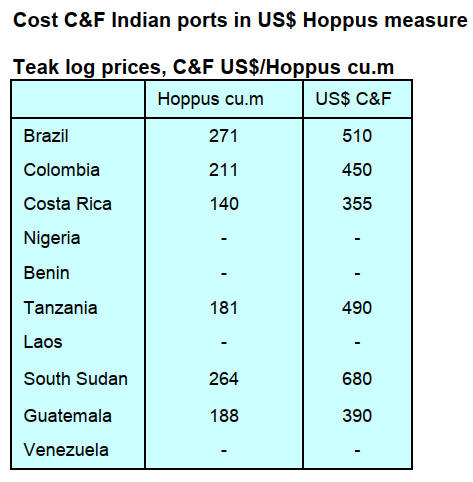 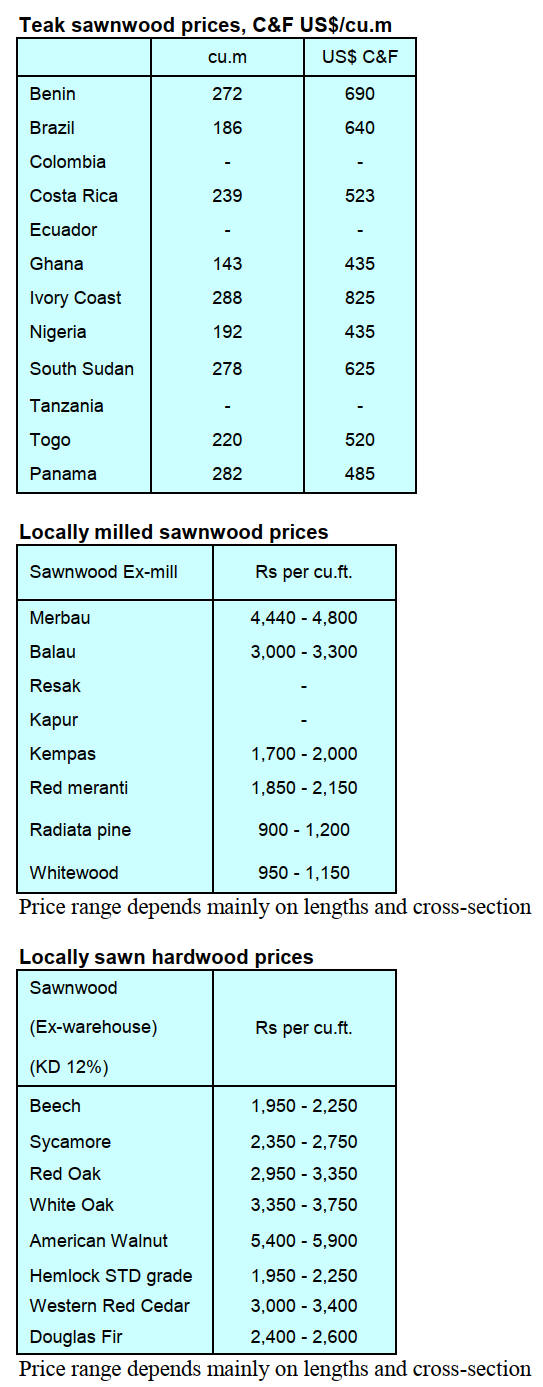
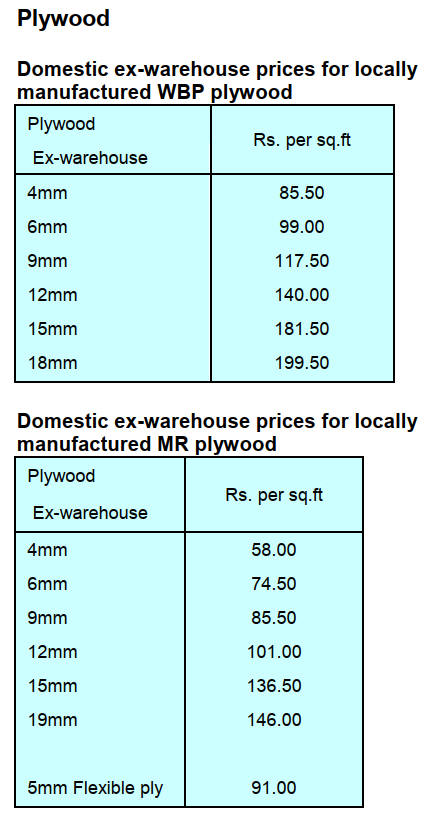
7.
VIETNAM
According to statistics from the Vietnam
Customs
Department, Vietnam’s W&WP exports to the Dutch
market in July 2025 reached US$13.8 million, more than
double that in July 2024. In the first 7 months of 2025
W&WP exports to the Dutch market were recorded at
US$51.1 million, up 14% over the same period in 2024.
Vietnam’s W&WP exports to Spain in July 2025
amounted to US$4.9 million, down 13% compared to July
2024. In the first 7 months of 2025 W&WP exports to the
Spanish market totaled US$7.7 million, up 37% over the
same period in 2024.
Vietnam's oak imports in July 2025 amounted to
67,700 cu.m, worth US$36.6 million, up 4% in volume
and 5% in value compared to June 2025 and up 69% in
volume and 60% in value compared to July 2024. In the
first 7 months of 2025 imports of this wood reached
311,209 cu.m, worth US$175.7 million, up 49% in volume
and 46% in value over the same period in 2024.
Vietnam’s raw wood (logs and sawnwood)
imports
from China in July 2025 totalled 112,000 cu.m, worth
about US$40 million, up 33% in volume and 25% in value
over the same period in 2024. Over the first 7 months of
2025 the total import volume of raw wood from China
totalled 865,480 cu.m, worth US$268.44 million, up 71%
in volume and 34% in value over the same period in 2024.
Vietnam’s W&WP exports in August 2025 were
valued at US$1.52 billion, up 1% compared to August
2024. Of this, WP exports alone, amounted to US$969.2
million, down 6% compared to August 2024. In the first 8
months of 2025 W&WP exports were US$11.2 billion, up
7% over the same period in 2024 of which WP exports
recorded at US$7.6 billion, up 6% over the same period in
2024.
Imports of raw wood (log and sawnwood) in August
2025 amounted to 697,800 cu.m, worth US$223.3 million,
up 4% in volume and 5.0% in value compared to July
2025. Compared to August 2024, there was an increase of
20% in volume and 25% in value. In the first 8 months of
2025 raw wood imports stood at 4.62 million cu.m, worth
US$1.47 billion, up 28% in volume and 25% in value over
the same period in 2024.
Vietnam’s NTFP exports in August 2025 dropped for
the 3rd consecutive month, valued at US$65 million, down
1.5% compared to July 2025 and down 3% over the same
period in 2024. NTFP exports in the first 8 months of 2025
fetched US$572.95 million, up 5% over the same period in
2024.
Vietnam’s wood industry sees strong growth
Year on year Vietnam’s total trade rose 16% in the first
half of 2025, with the wood and wood products sector
standing out as a key driver with a 9% growth,
underscoring a strong recovery according to the Vietnam
Chamber of Commerce and Industry (VCCI).
The remarks were made at the opening ceremony of the
Vietnam-ASEAN International Furniture and Handicraft
Products Fair (VIFA ASEAN 2025. The VCCI noted that
the US remains the primary market for Vietnamese wood
products with exports to this market climbing 12% and
accounting for more than 55% of total xports in the first
half of the year.
However, the organisation cautioned against relying too
heavily on a single market, stressing the importance of
diversification.
Speaking at the event, Vu Ba Phu, Director of the
Trade
Promotion Agency under the Ministry of Industry and
Trade, said VIFA ASEAN 2025 marks an important step
toward building Ho Chi Minh (HCMC) into a regional
trade hub.
He added that the ministry will continue supporting the
wood industry through digital transformation initiatives,
green production practices, and efforts to strengthen
Vietnam’s national brand.
Echoing this vision, Nguyen Van Dung, Vice Chairman of
the HCMC People’s Committee, highlighted the
advantages of integrating Binh Duong province into
HCMC.
This move, he said, creates a seamless supply chain - from
production in Binh Duong’s industrial parks to export
through HCMC’s major seaports.
HCMC, Binh Duong and Ba Ria-Vung Tau, all industrial
hubs in southern Vietnam, were recently merged to form
the new HCMC.
“With this alignment between the government and
businesses, we expect to generate new momentum for
sustainable growth in Vietnam’s wood industry and
solidify HCMC’s position as an essential destination on
the global trade map,” Dung said.
See: https://theinvestor.vn/vietnams-wood-industry-sees-strong-
growth-d16803.html
Vietnam's export orders rebound despite tariffs
Among seven countries surveyed by S&P Global in July,
Vietnam led with a PMI of 52.4, well above the ASEAN
average of 50.1. New export orders rose for the fourth
straight month reaching their fastest pace since November
2024.
This positive and surprising sign comes amid continued
concerns over the reciprocal tariffs from the US, a key
export market.
Ngo Sy Hoai, Vice President and General Secretary of the
Vietnam Timber and Forest Product Association
(VIFORES), noted that despite heavy impacts of the US
reciprocal tariffs and trade defense measures, timber and
wood product exports had reached US$9.6 billion by the
end of July, up 8% year on year.
The sector is projected to earn over US$7 billion in the
final five months of 2025 bringing the year’s total to
around US$17 billion, he said.
See: https://en.vietnamplus.vn/vietnams-manufacturing-sector-
returned-to-growth-in-july-post323838.vnp
Boosting imports from US to balance trade
In response to US trade actions Vietnamese timber firms
have stepped up imports of American logs and sawnwood.
In 2024 Vietnam purchased US$320 million in US wood
products.
During the first seven months of this year, imports
had
already reached US$321 million surpassing the previous
year’s total.
This shows Vietnam’s goodwill in narrowing the trade
surplus and supporting American timber producers, said
Hoai. If export conditions remain stable, imports from the
US are expected to keep rising, He added.
He said Vietnamese furniture exporters remain hopeful of
a fair and suitable tariff framework that avoids market
disruption and protects American consumer access to
Vietnamese products.
See: https://en.vietnamplus.vn/vietnams-export-orders-rebound-
amid-reciprocal-tariffs-post323993.vnp
Industry faces mounting challenges amid US tariff
pressure
Vietnam’s wood industries face mounting export
challenges as US tariffs, rising logistics costs and slowing
global demand squeeze profits and cloud the outlook for
the rest of 2025.
According to the latest data from the Department of
Customs, wood and wood products ranked seventh among
Vietnam’s top ten export categories in the first seven
months of 2025.
The US remained Vietnam’s largest export market
accounting for 56% of the total, up 11% year on year.
Vietnam’s strong position in the US market, now among
the top three wood exporters, is due to its cost advantages,
including low labour costs and the use of 70% of
domestically sourced materials.
However, the US administration announcement in early
April of a potential 46% countervailing tariff on
Vietnamese goods immediately placed the wood sector
among those most at risk.
If implemented, this tariff would significantly erode the
price competitiveness of Vietnamese wood products,
pushing up costs significantly.
During the tariff negotiation phase with businesses hopeful
for a more moderate 20% rate many leading exporters
ramped up production to seize a ‘golden window’,
resulting in relatively strong short-term growth.
Yet, business results from the second quarter of 2025
suggest that the anticipated recovery did not fully
materialise.
Looking ahead to the second half of the year, export
prospects appear even more uncertain. Tran Quoc Manh,
vice chairman of Vietnam Handicraft Exporters
Association, noted that adverse impacts are becoming
visible as early as the third quarter, particularly in August
and September.
"Most businesses are still operating but largely in a
holding pattern," Manh said. "Selling prices are falling,
product ranges are narrowing and many customers, despite
having placed orders, are delaying delivery ahead of
market developments.
Even import partners are uncertain about the situation,
which is causing transaction timelines to stretch out."
He added that, while the US market is already facing
difficulties, the European market continues to shrink,
increasing the pressure on Vietnamese exporters. The
situation is expected to deteriorate as orders continue to
decline.
Dang Quoc Hung, chairman and CEO of Alliance
Handicraft and Wooden Fine Art Corporation, warned that
the export wood market will face even greater challenges
in the near future.
recent shipments to the US have already encountered tax-
related hurdles and this is expected to continue affecting
orders in the upcoming months.
As taxes increase companies are forced to raise prices
which reduces competitiveness and directly hits sales,"
Hung explained.
Hung also pointed out a shift in buyer expectations.
"Previously, exporters typically absorbed all import taxes
for shipments to the US but now there is a push for shared
cost responsibility. This forces business to raise prices,
impacting customers and partners directly, some of whom
have already raised concerns in recent weeks."
Despite growing instability the Vietnam Timber and
Forest Products Association remains optimistic that the
country can still achieve its 2025 wood and wood product
export target of US$18 billion. However, the industry’s
heavy dependence on the US market poses significant
risks.
Any fluctuation in American consumer demand can
immediately affect Vietnam’s export revenues. As a result,
regulatory bodies are encouraging firms to diversify their
markets and tap into new growth areas.
Echoing this sentiment, Manh from the Vietnam
Handicraft Exporters Association said "In reality, this is
incredibly difficult. No market can replace the US in the
short term.
See: https://en.vietstock.vn/2025/08/wood-industry-faces-
mounting-challenges-amid-us-tariff-pressure-974-619810.htm
8. BRAZIL
With AI forestry sector begins a new era
The wood industry is one of the pillars of the Brazilian
economy with projected investments exceeding BRL105
billion by 2028 according to the Brazilian Tree Industry
Association (IBÁ).
The sector generates 690,000 direct jobs and
approximately 2 million indirect jobs. Facing challenges
such as monitoring, wildfires, pests, logistics,
environmental compliance and climate impacts, digital
transformation is essential to ensure efficiency and
sustainability in forest management.
In this context, Generative Artificial Intelligence (GenAI)
tools are emerging as a strategic support for forestry
operations. Intelligent assistants streamline data analysis,
while AI agents integrate systems and autonomously
execute processes, enhancing operational efficiency and
accuracy.
Practical applications include automatic pest detection
through drones and sensors, continuous monitoring for
wildfire prevention and the use of imagery and historical
data to estimate growth, timber volume and forecast
harvests thereby reducing costs and replacing manual
surveys.
Among national initiatives, the Netflora methodology,
developed by Embrapa, stands out. It employs drones and
AI to identify species in the Amazon with up to 95%
accuracy, expanding forest mapping capacity from 10,000
to 1 million hectares per year thus supporting timber
volume estimates, carbon stock assessments and harvest
planning.
To achieve such progress in an efficient and secure
manner specialised GenAI platforms are required. These
platforms combine frameworks and enterprise services to
accelerate implementation, ensure data privacy, process
large data volumes and allow scalability and continuous
updates.
By adopting GenAI the Brazilian forestry sector can
strengthen competitiveness and consolidate sustainable
practices that are essential for its future, balancing
productivity, environmental protection and technological
innovation.
See: https://www.maisfloresta.com.br/inovacao-e-
sustentabilidade-a-industria-florestal-entra-numa-nova-era-com-
a-genia/
Paraná Association seeks support to mitigate impact
of US tariffs
The timber sector in Brazil has major concerns on the
impact of US tariffs. In August 2025, the Paraná
Association of Forest-Based Companies (APRE Florestas)
held a meeting with the State Secretariat of Finance of
Paraná (Sefa) to discuss the impacts of tariffs of up to 50%
imposed by the US on forest products.
Between January and June 2025, the State concentrated
almost all of its forestry sector exports to the US market
with the following products: moldings (98%, US$102
million), wooden doors (96%, US$34 million), pine
plywood (34%, US$100 million) and pine sawnwood
(33%, US$26 million).
According to the Federation of Industries of Paraná
(FIEP), the crisis threatens more than 38,000 jobs and
could affect 67% of the municipalities in the State.
APRE has requested measures such as a state-level public
procurement programmes for wood products, expedited
reimbursement of the ICMS tax at all stages of the export
process and an update of Paraná’s Forestry Law aimed at
ensuring legal certainty and the sustainability of the sector.
Furthermore, the sector still faces the risk of additional
trade barriers in the US due to ongoing investigations
under Section 232 of the Trade Expansion Act which will
evaluate whether certain imports pose a threat to US
national security and may justify the imposition of
additional tariffs, as well as Section 301 of the Trade Act,
which allows unilateral trade retaliation to pressure market
liberalisation.
Given this scenario, APRE is urging stronger coordination
from public authorities to defend Paraná’s forestry sector,
in order to ensure the continuity of operations, safeguard
employment and maintain Paraná’s relevance in
international trade.
See: https://www.maisfloresta.com.br/apre-e-secretaria-da-
fazenda-estudam-medidas-emergenciais-para-conter-crise-no-
setor-florestal-do-parana/
Amazonian countries approve creation of ‘Tropical
Forests Forever Facility’
The nine Amazonian countries in South America (Brazil,
Peru, Colombia, Bolivia, Ecuador, Venezuela, Guyana,
French Guiana and Suriname) members of the Amazon
Cooperation Treaty Organization (ACTO) have approved
the establishment of the Tropical Forests Forever Facility
(TFFF), a financial mechanism dedicated to the
conservation, restoration and sustainable use of tropical
forests, with a particular focus on the Amazon.
The TFFF will be officially launched in Belém during
COP 30 (United Nations Framework Convention on
Climate Change (UNFCCC) and will serve as a
complementary instrument to existing climate and
environmental financing initiatives. It will operate on a
results-based payment system, incentivising deforestation
reduction, forest cover expansion and the valuation of
ecosystem services.
The joint communiqué of the ACTO Member States
highlights key points, including the mobilisation of
predictable and long-term financial resources from
investor countries, multilateral organisations, development
banks, climate funds, international cooperation agencies,
philanthropy and the private sector with concrete
contributions to capitalise the TFFF and ensure its swift
operationalisation.
It also emphasises that the TFFF´s design incorporates, as
a fundamental principle, the recognition of the strategic
role of Indigenous Peoples and Local Communities in
forest conservation. This is reflected, among other
measures, in the appropriate allocation of resources to
reward their conservation and sustainable development
efforts while acknowledging each country´s specific
circumstances.
The TFFF is conceived as complementary to other
international initiatives, such as the Paris Agreement, the
Convention on Biological Diversity (Kunming-Montreal
Global Biodiversity Framework) and the 2030 Agenda for
Sustainable Development.
It also strengthens regional cooperation under the ACTO,
consolidating the leadership of Global South countries in
creating innovative financial solutions to mobilise
resources for the conservation, restoration and sustainable
management of tropical forests.
The TFFF is presented as a pragmatic, transformative and
shared-governance mechanism, designed to foster
sustainable development and the well-being of present and
future generations.
See: https://omundodiplomatico.com.br/2025/08/28/paises-
amazonicos-aprovam-criacao-de-fundo-florestas-tropicais-para-
sempre/
Brazil and Chile at business roundtable
The governments of Brazil and Chile have discussed a
business partnership at meetings that brought together
government officials and business leaders to strengthen
bilateral trade and review progress of the Bioceanic Route,
which will connect the state of Mato Grosso do Sul to
Chilean ports, thus reducing logistics costs and enhancing
regional integration among Chile, Argentina, Paraguay
and Brazil.
During the Brazil-Chile Business Panel and Roundtable
held in Campo Grande in Mato Grosso do Sul, the Chilean
pulp and wood panel company, Arauco, explained its
strategic position in Brazil.
The company highlighted the importance of the Sucuriú
Project, currently under development in the municipality
of Inocência in the state of Mato Grosso do Sul,
representing investment in the construction of its first pulp
mill in Brazil scheduled to begin operations in 2027. The
new facility will account for 40% of Arauco’s global
production currently split among Chile, Argentina and
Uruguay.
Arauco also emphasised Brazil as a strategic global
partner, highlighting the project’s socioeconomic
potential, including job creation, workforce training,
investment attraction and promotion of regional
development.
See: https://www.maisfloresta.com.br/arauco-reforca-integracao-
entre-brasil-e-chile-em-rodada-de-negocios/
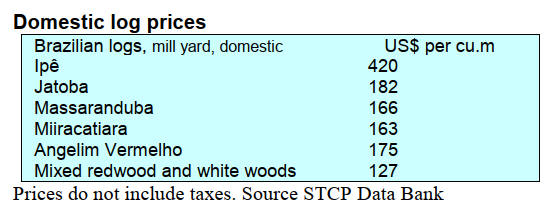
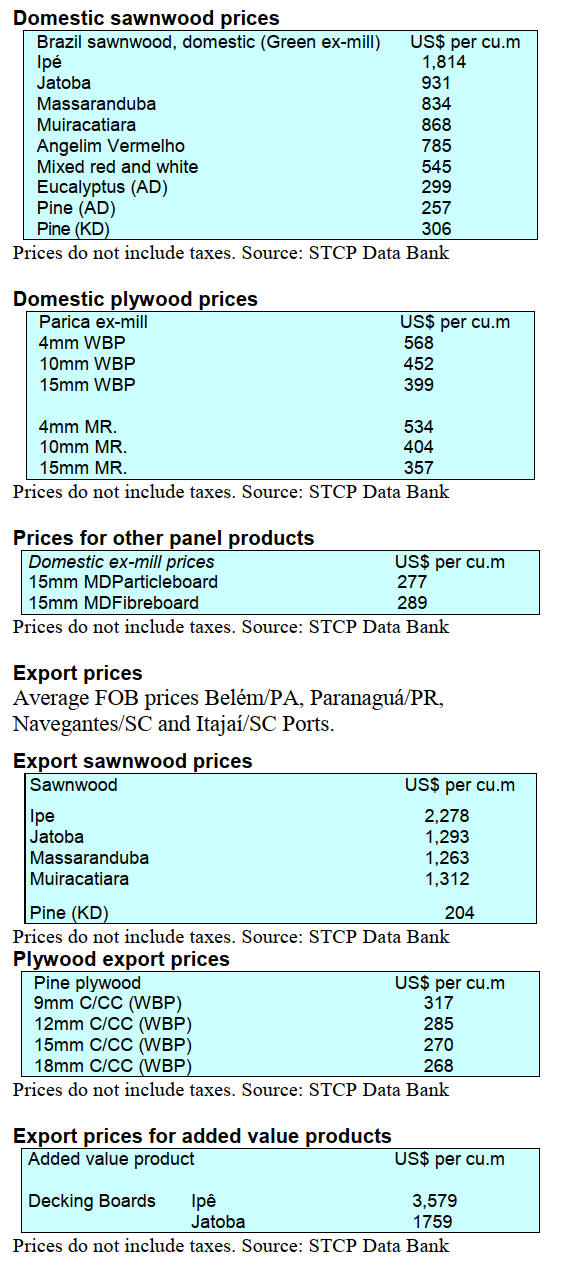
9. PERU
Grants
for commercial plantations in six Peruvian
Departments
More than 3,000 hectares of forest plantations will be
established over the next two years in six regions of the
country thanks to a grant of more than US$2 million
awarded by the National Forest and Wildlife Service
(SERFOR) through its Sustainable Productive Forests
Programme (BPS).
With this disbursement, 28 rural and indigenous
communities, associations and MSMEs will be able to
implement Forestry Business Plans agreed under the
Forest Incentives Program (PIF). It is expected that this
will benefit more than 6,000 families in the regions of
Áncash, Cajamarca, Huánuco, the Central Pasco Forest,
Junín and San Martín.
See: https://www.gob.pe/institucion/serfor/noticias/1239195-
midagri-serfor-otorga-mas-de-7-millones-de-soles-para-
impulsar-plantaciones-forestales-comerciales-en-seis-
departamentos-del-peru
Veneer and plywood exports impressive
According to information provided by the Services and
Extractive Industries Department of the Association of
Exporters (ADEX), veneer and plywood shipments during
the January-June 2025 period reached an FOB export
value of US$1.47 million, a positive 50% plus change
compared to the same period in 2024 (US$955,000).
The main destinations for exports in this subsector in the
first half were Mexico, a 49% share and a year on year
growth of 7% followed by Ecuador with a 33% share. In
third place was Colombia with an 8% share. The
Dominican Republic ranked fourth (7% share) and Costa
Rica concluded the top five with a 3% share.
Preventing forest fires and restoring Amazon
ecosystems
SERFOR has reaffirmed its commitment to the
conservation of the country's forests and wildlife through
the signing of an inter-institutional cooperation agreement
with the regional government of Ucayali, as well as with
the Ministry of the Environment (MINAM) through the
National Service of Protected Natural Areas (SERNANP).
These agreements aim to prevent forest fires and promote
the restoration of affected areas through technical
assistance, monitoring, training and investment projects in
reforestation with native species.
Peru is making progress in the implementation of the
National Strategy for the Restoration of Degraded
Ecosystems and Forest Lands (ProREST) 2021-2030 and
is strengthening its collaborative work with regions and
local communities, promoting sustainable productive
alternatives and reducing the practice of burning that
endangers life and the environment.
See:https://www.gob.pe/institucion/serfor/noticias/1239561-
serfor-refuerza-acciones-para-prevenir-incendios-forestales-y-
recuperar-ecosistemas-afectados-en-la-amazonia
In related news, SERFOR and the Technological Institute
of Production (ITP CITE Network) of the Ministry of
Production signed an agreement to promote the
development of the forestry sector in seven Peruvian
departments.
The agreement will be implemented through the ITP-CITE
Forestry Wood Network which brings together specialised
agencies in Ucayali, Loreto, Madre de Dios and Lima.
The initiative covers timber and non-timber product
processing and marketing with the goal of promoting
sustainable management that provides greater benefits to
families living in forests.
A training programme on reduced-impact logging
operations in natural forests will be held. Additionally,
studies on the properties of wood are planned, as well as
the promotion of training programs in low-impact
techniques.
See: https://www.gob.pe/institucion/serfor/noticias/1239981-
serfor-e-itp-firman-convenio-para-fortalecer-sector-forestal-en-
siete-departamentos
Peru, Brazil and Colombia - cooperation to combat
illegal logging
Illegal logging and illicit timber trafficking know no
borders and is a risk in the forests and communities of the
border areas between Peru, Brazil and Colombia.
Faced with this challenge more than 60 authorities and
specialists from the three countries participated in the
Regional Operational Cooperation Forum: Cross-Border
Coordination in Forest Crime Cases organised by the
United Nations Office on Drugs and Crime (UNODC) in
coordination with the Forest and Wildlife Resources
Oversight Agency (OSINFOR) and the International
Criminal Police Organization (INTERPOL).
Police officers, prosecutors and representatives from
ministries, environmental agencies and international
organisations met in Iquitos to strengthen cross-border
cooperation aimed at preventing, detecting and
investigating forest crimes.
The forum became a historic event where key information
on illegal routes and modus operandi was shared, field
simulations were conducted using investigative techniques
and technological innovations such as the use of satellite
imagery and artificial intelligence-based selective logging
detection algorithms were presented.
The delegations identified areas where activities affecting
the Amazon, such as illegal mining, illicit cropping,
deforestation and illegal logging are occurring, as well as
cross-border passageways for these illegal activities.
They established a framework for cooperation based on
intelligence gathering and analysis, early detection through
new technologies and the planning of joint investigations
and coordinated operations in shared territory.
Communication channels between agencies were also
strengthened, with a commitment to streamline data
exchange and coordinate joint actions in the most critical
areas.
See:https://www.gob.pe/institucion/osinfor/noticias/1239173-
peru-brasil-y-colombia-refuerzan-la-cooperacion-para-enfrentar-
la-tala-ilegal-en-el-trapecio-amazonico
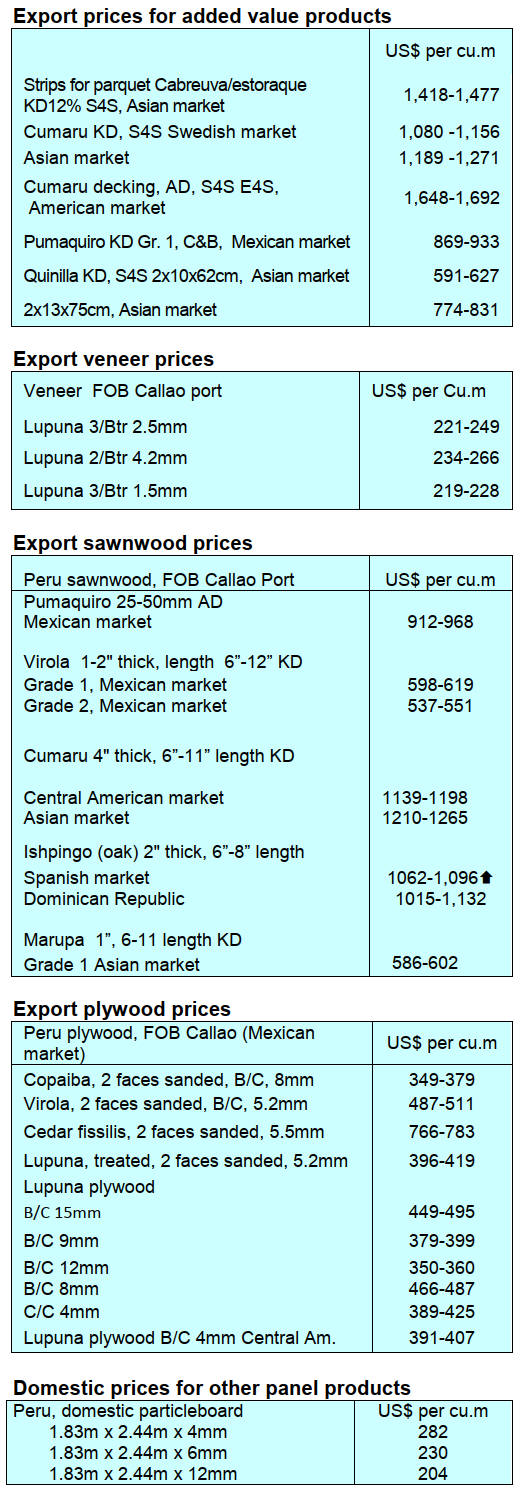
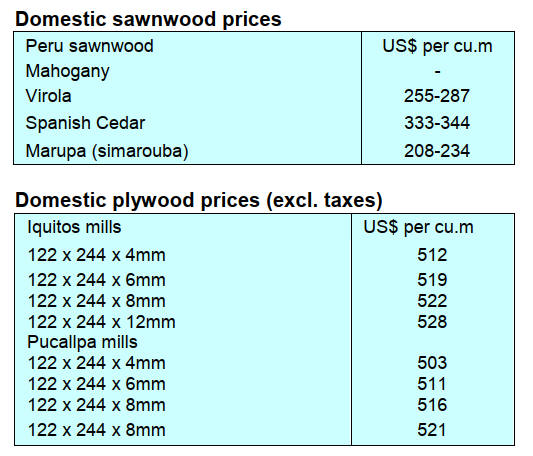
|